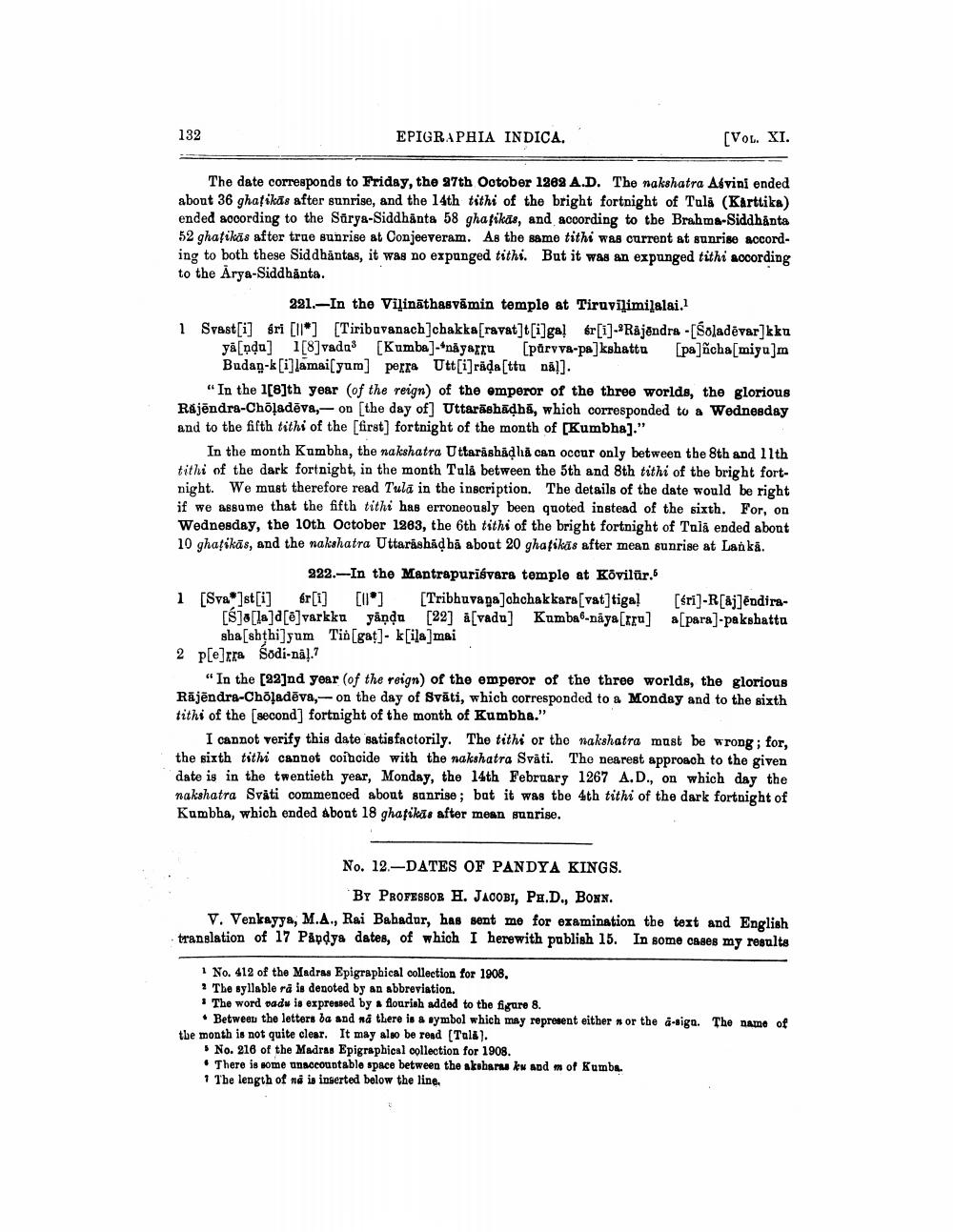________________
132
EPIGRAPHIA INDICA.
(VOL. XI.
The date corresponds to Friday, the 27th October 1202 A.D. The nakshatra Asvini ended about 36 ghatikās after sunrise, and the 14th tithi of the bright fortnight of Tula (Karttika) ended according to the Sarya-Siddhanta 58 ghafikās, and according to the Brahma-Siddhånta 52 ghafikas after true sunrise at Conjeeveram. As the same tithi was current at sunrise according to both these Siddhantas, it was no expunged tithi. But it was an expunged tithi according to the Arya-Siddhanta.
221.- In the Vilināthasvāmin temple at Tiruvilimiļalai.) 1 Svast[i] gri [ll] [Tiribavanach]chakkaravat]t[i]ga!6r[i]-PRåjëndra - [Soladēvar]kku
ya[ndu) [8]vadas (Kumba]-*näyarru (pårv va-pa]kshattu (pa]ñcha[miyu]m
Budap-k[i]lamai yum] pera Utt[i]rāda[ttu nä!).
"In the 1[8]th year of the reign of the emperor of the three worlds, the glorious Rájēndra-Choladēva,- op (the day of] Uttarăshādhi, which corresponded to a Wednesday and to the fifth tithi of the (first] fortnight of the month of [Kumbha)."
In the month Kumbha, the nakshatra Uttarishadhá can occur only between the 8th and 11th tithi of the dark fortnight, in the month Talá between the 5th and 8th tithi of the bright fortnight. We must therefore read Tula in the inscription. The details of the date would be right if we assume that the fifth tithi has erroneously been quoted instead of the sixth. For, on Wednesday, the 10th October 1283, the 6th tithi of the bright fortnight of Tuli ended about 10 ghafikas, and the nakahatra Uttarishad bå about 20 ghafilis after mean sunrise at Lanka.
222.-In the Mantrapurisvara temple at Kovilür. 1 [Sva]st[i] r[i] [11] [Tribhuvagalohchakkara[vat]tiga! [$ri)-R[$j]endira
[6]a[la]a[7]varkku yaņda [22] a[vada] Kumba-naya [xxu] [para)-paksbatta
sha[shthi]yum Tin [gat]- k[ila]mai 2 p[e]rra Sodi-na!.7
"In the [22]nd year of the roign) of the emperor of the three worlds, the glorious Rājēndra-Choladēva,-- on the day of Svāti, which corresponded to a Monday and to the sixth tithi of the [second] fortnight of the month of Kumbha."
I cannot verify this date satisfactorily. The tithi or the nakshatra must be wrong; for, the sixth tithi cannot coincide with the nakshatra Sväti. The nearest approach to the given date is in the twentieth year, Monday, the 14th February 1267 A.D., on which day the nakshatra Svati commenced about sanrise; bat it was the 4th tithi of the dark fortnight of Kumbha, which ended abont 18 ghafikas after mean sunrise.
No. 12.-DATES OF PANDYA KINGS.
BY PROFESSOR H. JACOBI, PA.D., Boxx. V. Venkayya, M.A., Rai Bahadur, has sent me for examination the text and English translation of 17 Påpdya dates, of which I herewith publish 15. In some cases my results
1 No. 412 of the Madras Epigraphical collection for 1908,
The syllable rá is denoted by an abbreviation. The word padw is expressed by flourish added to the figure 8.
• Between the letters ba and nd there is a symbol which may represent either or the a-siga. The name of the month is not quite clear. It may also be rend [Talk).
No. 216 of the Madras Epigraphical collection for 1908. • There is some unaccountable space between the aksharu ku and mof Kumbs. 1 The length of ná is inserted below the line




